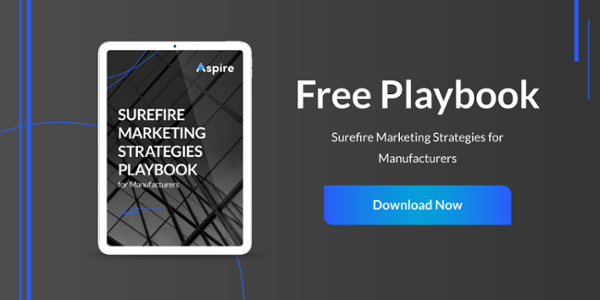- Marketing Strategy
- Manufacturing
- March 5, 2023
5 Step Roadmap to Sustainable B2B Manufacturer Growth in 2023

Aaron Marks

Between the pandemic and the fear of a recession, these recent years have left many B2B manufacturing companies struggling to grow. Traditional techniques like trade shows and print ads are no longer delivering needed growth. In turn, many manufacturers have turned to new ways to attract and retain customers in order to grow their business, like publishing on social media and email marketing.
But relying on individual marketing tactics like social media or SEO is no longer enough. Instead, manufacturers need a comprehensive marketing strategy that aligns with their business goals and supports their overall sales process.
Unfortunately, many manufacturers are falling behind in this area. They are still relying on outdated marketing tactics and failing to be strategic enough to do the things needed to consistently acquire leads and customers. They don't have a clear plan for how to attract new customers and keep them engaged throughout the sales process.
Today, manufacturers who continue to rely on "Random Acts of Marketing" and old-fashioned marketing tactics risk losing out to more nimble competitors who are embracing new marketing strategies. These competitors are leveraging the power of inbound marketing, developing personalized marketing strategies with account-based marketing, and optimizing their marketing efforts with the help of marketing automation tools like HubSpot.
In this blog post, we'll explore the 5 things manufacturers must do to grow in 2023. From developing a comprehensive marketing strategy to embracing inbound marketing and account-based marketing, we'll show you the strategies and tactics you need to stay ahead of the competition and grow your business in the coming year.
1. Develop a comprehensive marketing strategy.
One of the biggest mistakes that B2B manufacturers make is relying on individual marketing tactics without a comprehensive marketing strategy. As a result, you may not be effectively reaching your target audience or supporting your sales process. And without a clear plan for attracting and engaging new customers, you may be missing out on valuable opportunities to grow your business.
The truth is, developing a comprehensive marketing strategy can be daunting, especially if you're not a marketer. You're already juggling a lot of responsibilities, and marketing may not be your area of expertise. But the reality is that relying on individual marketing tactics without a thoughtful plan is no longer enough to drive growth. Without a clear plan, you risk wasting time and resources on tactics that don't deliver the results you need.
Fortunately, creating an effective marketing plan doesn't need to be an all-consuming, many-month-long process.
To get started with a solid marketing plan, identify your business objectives and break them down into specific marketing priorities. From there, develop a clear marketing strategy that aligns with your business goals and supports your overall sales process. This may involve identifying your target audience, developing your unique value proposition, and identifying the key channels and tactics that will help you reach your audience effectively.
To ensure your marketing plan is effective, be sure to measure your results regularly and make data-driven decisions based on what you learn. By constantly evaluating and optimizing your marketing efforts, you can maximize your ROI and stay ahead of the competition.
If this still feels intimidating, don't worry! Our downloadable marketing plan framework has everything you need to create a marketing strategy that will drive measurable results.
In the next sections of this blog post, we'll dive deeper into the specific marketing strategies and tactics you need to grow your business in 2023. But while you read that, keep in mind that your marketing plan is the foundation that makes these approaches work.
2. Embrace inbound marketing.
Your buyers are increasingly relying on the internet for research before making a purchasing decision. This means that manufacturers need to have a strong online presence in order to attract and engage potential customers. Inbound marketing is a powerful way to do this.
Inbound marketing is all about creating educational content that addresses the challenges and pain points of your ideal customer. By offering helpful information that is enormously insightful, unique, and helpful at every stage of their research, you can attract potential customers to your website and build trust with them.
Inbound marketing isn't truly about creating content. It's about building a relationship with your audience by nurturing them through their entire sales process. By offering a library of content and resources that help them address their challenges, you can help them – and ensure you keep your brand top of mind – while they move closer to making a purchasing decision.
The key to successful inbound marketing is to have a clear understanding of your ideal customer and their buying journey. By creating buyer personas and mapping out their journey from awareness to purchase, you can tailor your content to their needs and improve the chances of converting them into customers.
Inbound marketing is a long-term strategy that requires patience and persistence. But if done right, it can be a powerful way to attract and retain customers and drive sustainable growth for your manufacturing business.
3. Ensure that your website is optimized to convert.
Building a high-converting website is crucial for B2B manufacturers in 2023. Your website is often the first interaction a prospect has with your brand, and it needs to be more than just an online brochure. A high-converting website should have a clear message and calls-to-action that guide the visitor towards the next step in the sales process.
Of course, things like SEO and ease of use are essential to creating a high converting website. Your website should be optimized for search engines to ensure potential customers can easily find you. And once they do find you, your website should be easy to navigate, with a clear structure and user-friendly design. Make sure your website is mobile-responsive and loads quickly as well. These are "table stakes" for a website in 2023.
Once you have those basics down, make sure you have clear calls-to-action throughout your website. Don't just rely on a "Contact Us" page as the sole way for visitors to engage with your brand. Offer lead magnets, like eBooks or whitepapers, in exchange for contact information. This not only provides value to your visitors but also gives you the opportunity to nurture those leads over time.
We find that manufacturers who only rely on a "Contact Us" page typically see 0.2-0.4% of traffic turn into leads. Whereas manufacturers who include many different conversion options, like those lead magnets, can see that increase to 2-4%. That's right... simply increasing opportunities for conversion can increase your leads by 10x or more!
A newsletter can be a quick win in this regard. Make sure it's well-branded and includes a short value proposition that entices visitors to subscribe. Then, send out regular newsletters with helpful content that keeps your brand top-of-mind for potential customers.
4. Utilize account-based marketing (ABM).
Account-based marketing (ABM) is a personalized marketing strategy that focuses on targeting high-value accounts with customized messaging and content. In addition to your strategies that cast a wide net and catch a wide range of leads, ABM allows manufacturers to focus their resources on a specific set of high-value accounts, more akin to spearfishing.
Identifying high-value accounts is the first step in creating an ABM strategy. Look for accounts that align with your target customer profile, have a high potential for revenue, and are a good fit for your business. Once you've identified your target accounts, it's time to start crafting personalized messaging and content that speaks to the specific needs of decision-makers at those accounts.
The emphasis here is on personalized: the key to ABM success is heavy personalization.
One way to do this is by creating customized landing pages, webinars, or whitepapers tailored to each account. Another effective ABM tactic is to use personalized videos to engage with key decision-makers. This can be a powerful way to showcase your products and services in a way that resonates with your target audience.
But ABM isn't just about creating personalized content. It's also about creating personalized outreach strategies. This means that instead of relying on generic email campaigns, manufacturers should use targeted outreach tactics like to connect with decision-makers at their target accounts. Popular tactics here include personalized direct mail campaigns, gifting, and more.
One thing to keep in mind when implementing an ABM strategy is that it requires close alignment between sales and marketing teams. Sales teams should be heavily involved in identifying target accounts and in the ongoing strategy. I often use the analogy of "wrapping your arms around" your target accounts. Marketing is only one of the arms; sales is the other. To succeed, you need to tightly wrap both arms around your accounts.
5. Use CRM to analyze and optimize your marketing efforts.
Now that you're doing all of this work, analyzing and optimizing your marketing efforts is essential. But it's not always easy to know which metrics to track or how to interpret the data. Many manufacturers struggle with manual tracking, disparate data sources, and the challenge of proving ROI on marketing efforts. Without an effective system in place, it's impossible to know which marketing activities are driving results and which ones need to be adjusted or eliminated.
To get started, manufacturers should utilize a CRM and marketing automation tool like HubSpot to track and analyze their marketing results in real-time. By measuring key metrics like website traffic, lead generation, and sales, you can gain valuable insights into the effectiveness of your marketing efforts and make data-driven decisions to drive growth. Tools like HubSpot allow you to "close the loop" – that is, see which strategies and tactics are working to drive real results and which ones need to be adjusted or scrapped altogether.
One essential step is regularly reviewing and updating your marketing strategy. As your business and the market evolve, your marketing strategy should evolve as well. We often describe strategies as "written in pencil," because your learnings will necessitate changes to your strategy.
With the right tools and mindset, manufacturers can turn their marketing efforts into a powerful driver of growth and success.
Conclusion: Accelerate Your Growth in 2023 by Mastering These 5 Marketing Strategies for B2B Manufacturers
Albert Einstein once said that the definition of insanity is doing the same thing over and over again and expecting different results. As we've discussed in this blog post, relying on outdated marketing tactics alone, like print ads and trade shows, simply won't cut it in 2023. B2B manufacturers must be strategic and adapt to changing times if they want to grow their business.
By developing a comprehensive marketing strategy, embracing inbound marketing, building a high-converting website, utilizing account-based marketing, and analyzing and optimizing their marketing efforts, manufacturers can stay ahead of the competition and attract high-quality leads that convert into loyal customers.
At Aspire, we understand the unique challenges that B2B manufacturers face in today's ever-changing marketing landscape. That's why we offer a complimentary marketing assessment, tailored specifically to manufacturers. Our CEO will provide you with actionable insights and quick wins to improve your marketing efforts and grow your business. Get started with your complimentary assessment today!
Aaron Marks is the Chief Marketing Officer of Execo. A digital pioneer with nearly two decades of online marketing experience, Aaron has helped organizations ranging from fledgling startups to Fortune 500 enterprises, and global manufacturers to U.S. Presidential campaigns, get the marketing and business results they needed.


0 Comments